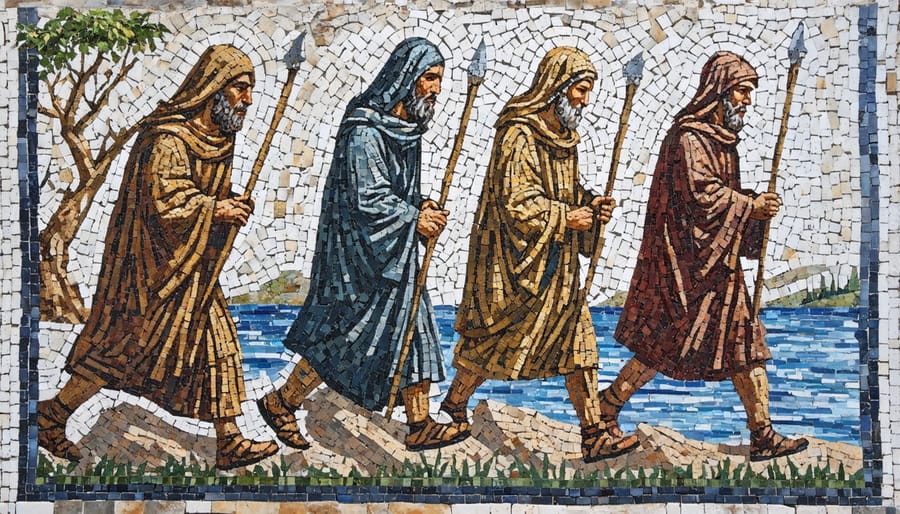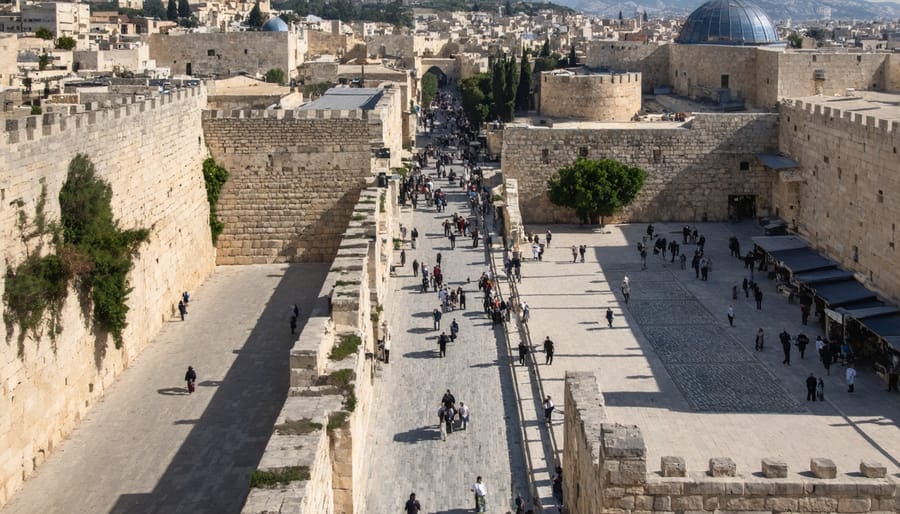Throughout history, pilgrims have embarked on sacred journeys that transforms your faith journey in profound ways. From the ancient pathways of Jerusalem to the winding trails of Spain’s Camino de Santiago, these holy expeditions represent more than mere travel—they embody the deepest expressions of faith, devotion, and spiritual transformation. Each year, millions of believers from diverse religious traditions traverse mountains, deserts, and ancient roads, seeking connection with the divine and deeper understanding of their faith. Whether following in the footsteps of Jesus through the Holy Land, joining the massive gathering at Mecca for the Hajj, or walking the paths of Buddhist temples in Japan, pilgrims discover that physical journey and spiritual growth are intimately intertwined. These sacred journeys offer a unique opportunity to step away from daily life’s distractions and enter into a space of profound spiritual reflection, community, and renewal. As we explore the world’s most significant religious pilgrimages, we’ll discover how these transformative experiences continue to shape faith, build community, and deepen spiritual understanding for believers across all traditions.
The Biblical Foundation of Pilgrimage
Ancient Paths of Faith
The Bible is rich with examples of transformative spiritual journeys that continue to inspire believers today. From Abraham’s faithful departure from Ur to the promised land, to the Israelites’ exodus from Egypt, these journeys represent more than mere physical movement – they symbolize deep spiritual transformation and obedience to God’s calling.
Moses’ journey up Mount Sinai to receive God’s commandments and Elijah’s forty-day trek to Mount Horeb demonstrate how physical pilgrimages often lead to profound divine encounters. Jesus Himself made regular pilgrimages to Jerusalem for religious festivals, setting an example of devotional travel that early Christians would follow.
For modern Christians, these biblical journeys offer powerful lessons about faith, perseverance, and spiritual growth. They remind us that sometimes God calls us to leave our comfort zones, just as He called Abraham, to experience deeper fellowship with Him. Whether walking the paths of the Holy Land or embarking on personal spiritual retreats, contemporary pilgrims can find inspiration in these ancient examples of faith-filled travel.
Today’s pilgrimages, while different in form, continue this sacred tradition of seeking God through intentional journey, allowing believers to physically participate in their spiritual heritage while drawing closer to their Creator.

Modern Relevance
In today’s fast-paced world, religious pilgrimages continue to offer Christians a profound way to connect with their faith and experience spiritual renewal. As ancient wisdom meets modern faith, these sacred journeys provide a unique opportunity to step away from daily distractions and focus entirely on our relationship with God.
Modern pilgrims often find that walking in the footsteps of saints and early Christians helps them better understand Scripture and deepen their faith journey. Whether visiting the Holy Land, walking the Camino de Santiago, or participating in local pilgrimages, believers discover that these experiences create lasting spiritual impact in their lives.
Technology has made pilgrimages more accessible than ever, with virtual tours and online communities supporting those who cannot travel physically. Many churches now organize group pilgrimages that combine traditional spiritual practices with contemporary worship experiences, making these sacred journeys relevant for all generations of believers.
The enduring appeal of pilgrimages reminds us that while our world changes rapidly, our deep longing for meaningful connection with God remains constant. Through these journeys, we continue to find fresh expressions of faith while honoring time-honored traditions.
Transformative Pilgrimage Destinations

The Holy Land Experience
Walking in the footsteps of Jesus through Jerusalem and its surrounding areas offers believers an unparalleled opportunity to experience Scripture coming alive before their eyes. As you traverse the ancient streets of Jerusalem’s Old City, you can almost hear the echoes of Jesus’ teachings and feel the weight of history in every stone.
The Via Dolorosa, traditionally believed to be the path Jesus walked carrying His cross, winds through narrow streets where pilgrims often pause for prayer and reflection at each of the fourteen Stations of the Cross. The journey culminates at the Church of the Holy Sepulchre, venerated as the site of Christ’s crucifixion, burial, and resurrection.
Just outside Jerusalem’s walls, the Garden of Gethsemane still grows ancient olive trees, some dating back to Jesus’ time. Here, visitors can spend quiet moments in prayer, reflecting on Jesus’ agony and submission to the Father’s will. The nearby Mount of Olives provides a breathtaking panorama of Jerusalem, the same view Jesus would have had as He wept over the city.
In Bethlehem, just six miles south of Jerusalem, pilgrims visit the Church of the Nativity, built over the cave where tradition holds Jesus was born. The humble setting serves as a powerful reminder of God’s incarnation. The Shepherd’s Fields nearby echo with the angels’ proclamation of Christ’s birth.
The Sea of Galilee region offers sites where Jesus performed many miracles and taught His disciples. From Capernaum, Jesus’ ministry base, to the Mount of Beatitudes, these locations help believers connect deeply with Gospel narratives and experience their faith in tangible ways.
Throughout these holy sites, Scripture takes on new dimensions as geographical context brings biblical accounts into sharper focus, deepening faith and understanding.
The Way of St. James
The Way of St. James, also known as the Camino de Santiago, stands as one of Christianity’s most revered pilgrimages, drawing faithful seekers from across the globe to walk in the footsteps of countless pilgrims before them. This ancient network of routes leads to the Cathedral of Santiago de Compostela in Spain, where tradition holds that the remains of the apostle Saint James are enshrined.
For centuries, pilgrims have embarked on this transformative journey, carrying with them their prayers, burdens, and hopes. As Scripture reminds us, “They go from strength to strength, till each appears before God in Zion” (Psalm 84:7). The Camino offers a unique opportunity for spiritual reflection and growth, as pilgrims typically walk between 15-25 miles per day, experiencing both physical challenges and moments of profound spiritual connection.
The most popular route, the Camino Francés, stretches approximately 500 miles from Saint-Jean-Pied-de-Port in France to Santiago. Along the way, pilgrims encounter fellow travelers from diverse backgrounds and faith traditions, sharing meals, stories, and encouragement. This community aspect of the journey often becomes as meaningful as the destination itself, embodying the Christian principles of fellowship and mutual support.
Many pilgrims report experiencing deep spiritual renewal during their journey, finding that the simplicity of walking, praying, and connecting with others creates space for God to work in powerful ways. The physical act of pilgrimage becomes a metaphor for the spiritual journey, reminding us that our entire life is a walk with Christ, filled with challenges, joys, and opportunities for growth in faith.

Rome and Vatican City
Rome and the Vatican City stand as the spiritual epicenter of Catholic Christianity, drawing millions of pilgrims annually who seek to deepen their faith and walk in the footsteps of countless saints. At the heart of this holy destination lies St. Peter’s Basilica, built over the tomb of the Apostle Peter, where pilgrims can experience the profound connection to the early Christian church and its foundational figures.
The Vatican Museums house some of Christianity’s most treasured artworks, including Michelangelo’s awe-inspiring Sistine Chapel ceiling, which has moved believers to tears with its powerful depiction of biblical narratives. As pilgrims gaze upward at these masterpieces, many find themselves contemplating the words of Psalm 19:1, “The heavens declare the glory of God; the skies proclaim the work of his hands.”
Beyond the Vatican walls, Rome’s ancient churches offer deeply moving pilgrim experiences. The Basilica of St. John Lateran, the mother church of all Catholic churches worldwide, and the Basilica of Santa Maria Maggiore, dedicated to the Virgin Mary, provide spaces for quiet reflection and prayer. The Scala Santa (Holy Stairs), believed to be the steps Jesus climbed during His passion, offers pilgrims a unique opportunity for meditation on Christ’s sacrifice.
Perhaps most poignantly, the Roman catacombs remind visitors of the early Christians’ unwavering faith amid persecution. Walking through these ancient burial tunnels, pilgrims often feel a profound connection to the cloud of witnesses described in Hebrews 12:1, who maintained their faith despite tremendous challenges.
Visiting Rome isn’t merely about seeing historical sites; it’s about experiencing a living testimony to two thousand years of Christian faith. Whether participating in a Papal Audience, praying at the tombs of saints, or simply sitting in quiet contemplation in one of Rome’s countless churches, pilgrims often describe their journey as transformative, deepening their relationship with God and strengthening their connection to the universal Church.
Preparing for Your Spiritual Journey
Spiritual Preparation
The spiritual journey of a pilgrimage begins long before the first physical step is taken. As Scripture teaches us, “Prepare your minds for action” (1 Peter 1:13), and this preparation is essential for experiencing the full spiritual significance of your sacred journey. Engaging in dedicated prayer and meditation practices helps create a receptive heart and focused mind for the transformative experience ahead.
Begin your preparation by setting aside regular times for prayer, asking God to guide your journey and open your heart to His presence. Many pilgrims find it beneficial to keep a spiritual journal during this preparatory phase, recording their hopes, prayers, and revelations. Reading accounts of other pilgrims’ experiences and studying the biblical significance of your chosen destination can deepen your spiritual connection to the journey.
Fasting and special devotional practices have traditionally been part of pilgrimage preparation. While these practices may vary among different Christian traditions, the core purpose remains the same: to create space in our lives for God’s presence and guidance. Consider incorporating regular Scripture reading focused on themes of journey, seeking, and spiritual transformation.
Remember Jesus’s words, “Ask and it will be given to you; seek and you will find” (Matthew 7:7). This preparation time is an opportunity to align your heart with God’s purposes for your pilgrimage. Many find it helpful to join with fellow believers in prayer groups or seek guidance from spiritual mentors who have experience with pilgrimages. This communal aspect of preparation can provide both support and deeper insights into the spiritual significance of your upcoming journey.
Practical Considerations
Embarking on a religious pilgrimage requires careful preparation, both spiritually and practically. Begin by researching your chosen destination’s climate, cultural customs, and specific religious requirements. Many sacred sites have dress codes – typically modest clothing that covers shoulders and knees – and may require head coverings for both men and women.
Pack light but thoughtfully. Essential items include comfortable walking shoes, weather-appropriate clothing, basic first aid supplies, and any necessary documentation. For longer pilgrimages like the Camino de Santiago, consider investing in quality backpacking gear and breaking in your shoes well before departure.
Physical preparation is crucial for pilgrimages involving extensive walking. Start a walking routine several months before your journey, gradually increasing distance and incorporating varied terrain. Remember that many historic pilgrimage sites may not be easily accessible, so assess your physical capabilities honestly and plan accordingly.
Practical spirituality matters too. Bring a small Bible or devotional book, a journal for reflection, and any meaningful religious items that won’t burden your journey. Consider downloading religious apps or audio content for spiritual nourishment along the way.
Be mindful of timing your pilgrimage. Many sites experience peak crowds during major religious festivals or favorable weather seasons. Book accommodations in advance where possible, especially in popular destinations like Jerusalem or Rome. Also, research local customs about offerings or donations at religious sites to prepare appropriately.
Remember that pilgrimage is as much about the journey as the destination. Pack patience, humility, and an open heart alongside your physical provisions. As Scripture reminds us, “Your word is a lamp for my feet, a light on my path” (Psalm 119:105).
Throughout history, pilgrimage has served as a powerful catalyst for spiritual transformation, offering Christians a unique opportunity to deepen their faith and experience God’s presence in profound ways. Like the stages of spiritual growth, pilgrimage represents a journey both physical and spiritual, leading believers toward a deeper understanding of their faith and relationship with God.
The act of leaving behind familiar surroundings, stepping out in faith, and following in the footsteps of countless believers before us creates a sacred space for reflection, renewal, and revelation. Whether walking the ancient paths of Jerusalem, kneeling in prayer at Rome’s holy sites, or traversing the Camino de Santiago, pilgrims often report experiencing God’s presence in transformative ways that continue to impact their lives long after returning home.
As we conclude our exploration of religious pilgrimages, let us remember that every step taken in faith brings us closer to understanding God’s purpose for our lives. The spiritual disciplines developed during pilgrimage – prayer, meditation, community, and perseverance – become lifelong practices that enrich our walk with Christ. In the words of Hebrews 11:13, we are all “strangers and pilgrims on the earth,” seeking our true home in God’s presence.
May we embrace the pilgrim’s heart in our daily walk with Christ, recognizing that every journey undertaken in faith has the potential to transform not only our own lives but also the lives of those we encounter along the way.
